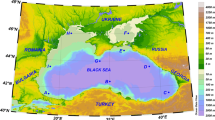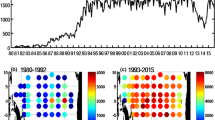Abstract
This observational study mainly examines the impacts of short- and long-time fluctuations of surface wind fields over the Arabian Sea (AS), the Bay of Bengal (BoB), and the southern Indian Ocean (SIO) on Indian Summer Monsoon Rainfall (ISMR), with special reference to strong and weak Indian summer monsoons (ISM). Two datasets over 1991–2014 are used: (1) the daily gridded rainfall produced by India Meteorological Department (IMD), and (2) the Cross-Calibrated Multi-Platform (CCMP) wind product version 2.0 created by Remote Sensing Systems. Monthly mean surface wind speed, convergence, and curl in the AS, BoB, and SIO are overall not significantly different between strong and weak ISMRs except for wind speed in the AS in September. However, the probability density function (PDF) distribution of daily values over the AS, BoB, and SIO during strong ISMRs is different from during weak ISMs, suggesting that sub-monthly surface wind characteristics could be useful in diagnosing rainfall characteristics. Except for rainfall in the northeast part of India, Indian regional rainfalls are closely linked with surface wind speeds over the AS, and wind convergence and curl over the BoB on short timescales of up to 1 week. The daily area-averaged wind convergence over the BoB is better correlated with regional rainfall during strong ISMs than during weak ISMRs. Multiple linear regression analysis shows that the fluctuations of monthly wind fields in the AS and BoB can affect monthly rainfall in some regions but are not related to a significant change in rainfall over the whole India. It is the short-time fluctuations of wind speed over the AS as well as wind convergence and curl over the BoB rather than their long (monthly) timescale fluctuations that are related to the strength of ISMR. Surface winds over the SIO on weather timescales have little influence on ISMR.














Similar content being viewed by others
References
Ailikun B, Yasunari T (1998) On the two indices of Asian summer monsoon variability and their implications. Extended Abstracts, Int. Conf. on Monsoon and Hydrologic Cycle, Kyongju, Korea, Korean Meteorological Society, pp 222–224
Allaby M (2002) Encyclopedia of weather and climate, facts on files publishing, p 373. ISBN 0816040710, 9780816040711
Annamalai H, Slingo JM (2001) Active/break cycles: Diagnosis of the intraseasonal variability of the Asian summer monsoon. Clim Dyn 18:85–102
Ashok K, Guan Z, Yamagata T (2001) Impact of the Indian Ocean Dipole on the relationship between the Indian monsoon rainfall and ENSO. Geophys Res Lett 28(23):4499–4502. https://doi.org/10.1029/2001GL013294
Atlas R, Hoffman RN, Bloom SC, Jusem JC, Ardizzone J (1996) A multiyear global surface wind velocity dataset using SSM/I wind observations. Bull Am Meteorol Soc 77:869–882
Atlas R, Hoffman RN, Ardizzone J, Leidner SM, Jusem JC, Smith DK, Gombos D (2011) A cross-calibrated, multiplatform ocean surface wind velocity product for meteorological and oceanographic applications. Bull Am Meteorol Soc 92:157–174. https://doi.org/10.1175/2010BAMS2946.1
Bhanu Kumar OSRU (1988) Eurasian snow cover and seasonal forecast of Indian summer monsoon rainfall. Hydrol Sci J 33(5):515–525. https://doi.org/10.1080/02626668809491278
Blanford HF (1884) On the connection of Himalayan snowfall with dry winds and seasons of drought in India. Proc R Soc Lond 37:3–22
Cadet DL, Greco S (1987a) Water vapor transport over the Indian Ocean during the 1979 summer monsoon Part 1: Water vapour fluxes. Mon Weather Rev 115:653–663
Cadet DL, Greco S (1987b) Water vapor transport over the Indian Ocean during the 1979 summer monsoon Part 2: Water vapor budgets. Mon Weather Rev 115:2358–2366
Charney JG, Shukla J (1981) Predictability of monsoons. In: Lighthill J, Pearce RP (eds) Monsoon dynamics. Cambridge University Press, Cambridge, pp 99–109
Chatterjee P, Goswami BN (2004) Structure, genesis and scale selection of the tropical quasi-biweekly mode. Q J R Meteorol Soc 130:1171–1194
Chen TC, Chen JM (1993) The 10 to 20-day mode of the 1979 Indian monsoon: Its relation with the time variation of monsoon rainfall. Mon Weather Rev 121:2465–2482
Choudhury BA, Saha SK, Konwar M, Sujith K, Deshamukhya A (2019) Rapid drying of Northeast India in the last three decades: climate change or natural variability? J Geophys Res 124:227–237. https://doi.org/10.1029/2018JD029625
Dey B, Bhanu Kumar OSRU (1982) An apparent relationship between Eurasian snow cover and the advanced period of the Indian summer monsoon. J Appl Meteor 21:1929–1932
Dey B, Bhanu Kumar OSRU (1983) Himalayan winter snow cover area and summer monsoon rainfall over India. J Geophys Res 88:5471–5474
Dickson RR (1984) Eurasian snow cover versus Indian monsoon rainfall—an extension of the Hahn-Shukla results. J Clim Appl Meteorol 171–173
Findlater J (1969) A major low-level air current near the Indian Ocean during the northern summer. Q J R Meteorol Soc 95:362–380. https://doi.org/10.1002/qj.49709540409
Fukutomi Y, Yasunari T (1999) 10–25 day intraseasonal variations of convection and circulation over east Asia and western north Pacific during early summer. J Metorol Soc Japan 77(3):753–769
Goswami BN, Xavier PK (2005) ENSO control on the south Asian monsoon through the length of the rainy season. Geophys Res Lett 32:L18717. https://doi.org/10.1029/2005GL023216
Goswami BN, Krishnarmurthy V, Annamalai H (1999) A broad scale circulation index for the interannual variability of the Indian summer monsoon. Q J R Meteorol Soc 125:611–633
Goswami BN, Ajayamohan RS, Xavier PK, Sengupta D (2003) Clustering of synoptic activity by Indian summer monsoon intraseasonal oscillations. Geophys Res Lett 30:1431. https://doi.org/10.1029/2002GL016734
Govardhan D, Rao VB, Ashok K (2017) Understanding the revival of the Indian summer monsoon after breaks. J Atmos Sci 74:1417–1429. https://doi.org/10.1175/JAS-D-16-0325.1
Hahn DJ, Shukla J (1976) An apparent relationship between Eurasian snow cover and Indian monsoon rainfall. J Atmos Sci 33:2461–2462
Hoffman RN, Leidner M, Henderson JM, Atlas R, Ardizzone JV, Bloom SC (2003) A two-dimensional variational analysis method for NSCAT ambiguity removal: methodology, sensitivity, and tuning. J Atmos Oceanic Technol 20:585–605
Joseph PV, Mukhopadhyaya RK, Dixit WV, Vaidya DV (1981) Meridional wind index for long range forecasting of Indian summer monsoon rainfall. Mausam 32:31–34
Kikuchi K, Wang B, Kajikawa Y (2012) Bimodal representation of the tropical intraseasonal oscillation. Clim Dyn 38:1989–2000. https://doi.org/10.1007/s00382-011-1159-1
Konwar M, Parekh A, Goswami BN (2012) Dynamics of east-west asymmetry of Indian summer monsoon rainfall trends in recent decades. Geophys Res Lett 39:L10708. https://doi.org/10.1029/2012GL052018
Krishnamurthy L, Krishnumurthy V (2014) Influence of PDO on south Asian summer monsoon and monsoon-ENSO relation. Clim Dyn 42:2397–2410. https://doi.org/10.1007/s00382-013-1856-z
Krishnamurthy V, Shukla J (2000) Intraseasonal and interannual variability of rainfall over India. J Clim 13:4366–4377
Krishnamurti TN, Ardunay P (1980) The 10 to 20 day westward propagating mode and breaks in the monsoons. Tellus 32:15–26
Krishnan R, Swapna P (2009) Significant influence of the boreal summer monsoon flow on the Indian Ocean response during dipole events. J Clim 22:5611–5634. https://doi.org/10.1175/2009jCLI2176.1
Kulkarni A, Sabade SS, Kripalani RH (2006) Intra-seasonal vagaries of the Indian summer monsoon rainfall. Indian Institute of Tropical Meteorology, ISSN 0252-1075, Research Report No. RR-114
Lau KM, Chan PH (1986) Aspects of the 40–50 day oscillation during the northern summer as inferred from ongoing longwave radiation. Mon Wea Rev 114:1354–1367
Levine RC, Turner AG (2012) Dependence of Indian monsoon rainfall on moisture fluxes across the Arabian Sea and the impact of coupled model sea surface temperature biases. Clim Dyn 38:2167–2190
Li J, Zeng Q (2002) A unified monsoon index. Geophys Res Lett 29(8):1274. https://doi.org/10.1029/2001GL013874
Malik A, Brönnimann S (2018) Factors affecting the inter-annual to centennial timescales variability of Indian summer monsoon rainfall. Clim Dyn 50:4347–4364. https://doi.org/10.1007/s00382-017-3879-3
Malik A, Brönnimann S, Stickler A, Raible CC, Muthers S, Anet J, Rozanov E, Schmutz W (2017) Decadal to multi-decadal scale variability of Indian summer monsoon rainfall in the coupled ocean–atmosphere-chemistry climate model SOCOL-MPIOM. Clim Dyn 49:3551–3572. https://doi.org/10.1007/s00382-017-3529-9
Pai DS, Sridhar L, Kumar R (2016) Active and break events of Indian summer monsoon during 1901–2014. Clim Dyn 46:3921–3939. https://doi.org/10.1007/s00382-015-2813-9
Parthasarathy B, Sontakke NA, Munot AA, Kothawale DR (1990) Vagaries of Indian monsoon rainfall and its relationship with regional/global circulations. Mausam 41:301–308
Parthasarathy B, Kumar KR, Deshpande VR (1991) Indian summer monsoon rainfall and 200-mbar meridional wind index: application for long-range prediction. Int J Climatol 11:165–176. https://doi.org/10.1002/joc.3370110205
Parthasarathy B, Kumar RR, Kothawale DR (1992) Indian summer monsoon rainfall indices, 1871–1990. Meteor Mag 121:174–186
Pattanaik DR (2007a) Analysis of rainfall over different homogeneous regions of India in relation to variability in westward movement frequency of monsoon depressions. Nat Hazards 40:635–646
Pattanaik DR (2007b) Variability of convective activity over the northern Indian Ocean and its association with monsoon rainfall over India. Pure Appl Geophys 164:1527–1545
Rao Y (1976) Southwest monsoon; meteorological monograph, synoptic meteorology, No 1/1976, India Meteorological Department
Sadhuram Y, Ramesh Kumar MR (1988) Does evaporation over the Arabian Sea play a crucial role in moisture transport across the west coast of India during an active monsoon period? Mon Weather Rev 116:307–312
Saha SK, Hazra A, Pokhrel S, Chadhari HS, Sujith K, Rai A, Rahaman H, Goswami BN (2019) Unraveling the mystery of Indian summer monsoon prediction: improved estimate of predictability limit. J Geophys Res 124:1962–1974. https://doi.org/10.1029/2018JD030082
Sikka DR, Gadgil S (1980) On the maximum cloud zone and the ITCZ over India longitude during the southwest monsoon. Mon Weather Rev 108:1840–1853
Singh OP, Ali Khan TM, Rahman DdS (2001) Has the frequency of intense tropical cyclones increased in the north Indian Ocean? Curr Sci 80(4):575–580
Skula J (1987) Interannual variability of monsoons. In: Fein, Stephens (eds) Monsoons. Wiley, pp 399–464
Sreejith OP, Panickal S, Pai S, Rajeevan M (2015) An Indian Ocean precursor for Indian summer monsoon rainfall variability. Geophys Res Lett 42:9345–9354. https://doi.org/10.1002/2015GL065950
Varikoden H, Revadekar JV, Kuttippurath J, Babu CA (2019) Contrasting trends in southwest monsoon rainfall over the Western Ghats region of India. Clim Dyn 52:4557–4566. https://doi.org/10.1007/s00382-018-4397-7
Venugopal T, Ali MM, Bourassa MA, Zheng Y, Goni GJ, Foltz GR, Rajeevan M (2018) Statistical evidence for the role of southwestern Indian Ocean heat content in the Indian summer monsoon rainfall. Sci Rep 8:12092. https://doi.org/10.1038/s41598-018-30552-0
Verma RK, Kmate PP (1980) Statistical technique for long-range forecasting of summer monsoon activity over India. In: Proceeding of symposium on the probabilistic and statistical methods in weather forecastings, 8–12 September 1980, Nice, World Meteorological Organization, Geneva, pp 303–307
Vernekar AD, Zhou J, Shukla J (1995) The effect of Eurasian snow cover on the Indian Monsoon. J Clim 8:248–266
Walker GT (1910) On the meteorological evidence for supposed changes of climate in India. Mem Indian Meteor 21:1–21
Wang B, Fan Z (1999) Choice of south Asian summer monsoon indices. Bull Am Meteor Soc 80:629–638
Webster P, Yang S (1999) Monsoon and ENSO: Selectively interactive systems. Q J R Meteorol Soc 118:877–926
Webster PJ, Magana VO, Palmer TN, Shukla J, Tomas RT, Yanai M, Yasunari T (1998) Monsoons: processes, predictability and the prospects of predictions. J Geophys Res 103:14451–14510
Yusunari T (1979) Cloudiness fluctuation associated with the norther hemisphere summer monsoon. J Meteorol Soc Japan 57:227–242
Zheng Y, Ali MM, Bourassa MA (2016a) Contribution of monthly and regional rainfall to the strength of Indian summer monsoon. Mon Weather Rev 144:3037–3055. https://doi.org/10.1175/MWR-D-15-0318.1
Zheng Y, Bourassa MA, Ali MM, Krishnamurti TN (2016b) Distinctive features of rainfall over the Indian homogeneous rainfall regions between strong and weak Indian summer monsoons. J Geophys Res Atmos. https://doi.org/10.1002/2016JD025135
Acknowledgements
We are grateful to the India Meteorological Department that provides the latest daily gridded rainfall data. We also greatly appreciate Remote Sensing Systems (RSS) for providing the Cross-Calibrated Multi-Platform (CCMP) Version 2.0 vector wind product. Data are available at https://www.remss.com. The Center for Ocean-Atmospheric Prediction Studies (COAPS) at the Florida State University provides computational facilities for this study. The study is fully supported by the National Aeronautics and Space Administration (NASA) Physical Oceanography in support of the Ocean Vector Winds Science Team (OVWST), NASA NEWS, and the NOAA Climate Observing Division (COD). We thank four anonymous reviewers for their insightful comments leading to the improvement of manuscript.
Author information
Authors and Affiliations
Corresponding author
Additional information
Publisher's Note
Springer Nature remains neutral with regard to jurisdictional claims in published maps and institutional affiliations.
Rights and permissions
About this article
Cite this article
Zheng, Y., Bourassa, M.A. & Ali, M.M. Statistical evidence on distinct impacts of short- and long-time fluctuations of Indian Ocean surface wind fields on Indian summer monsoon rainfall during 1991–2014. Clim Dyn 54, 3053–3076 (2020). https://doi.org/10.1007/s00382-020-05156-y
Received:
Accepted:
Published:
Issue Date:
DOI: https://doi.org/10.1007/s00382-020-05156-y




